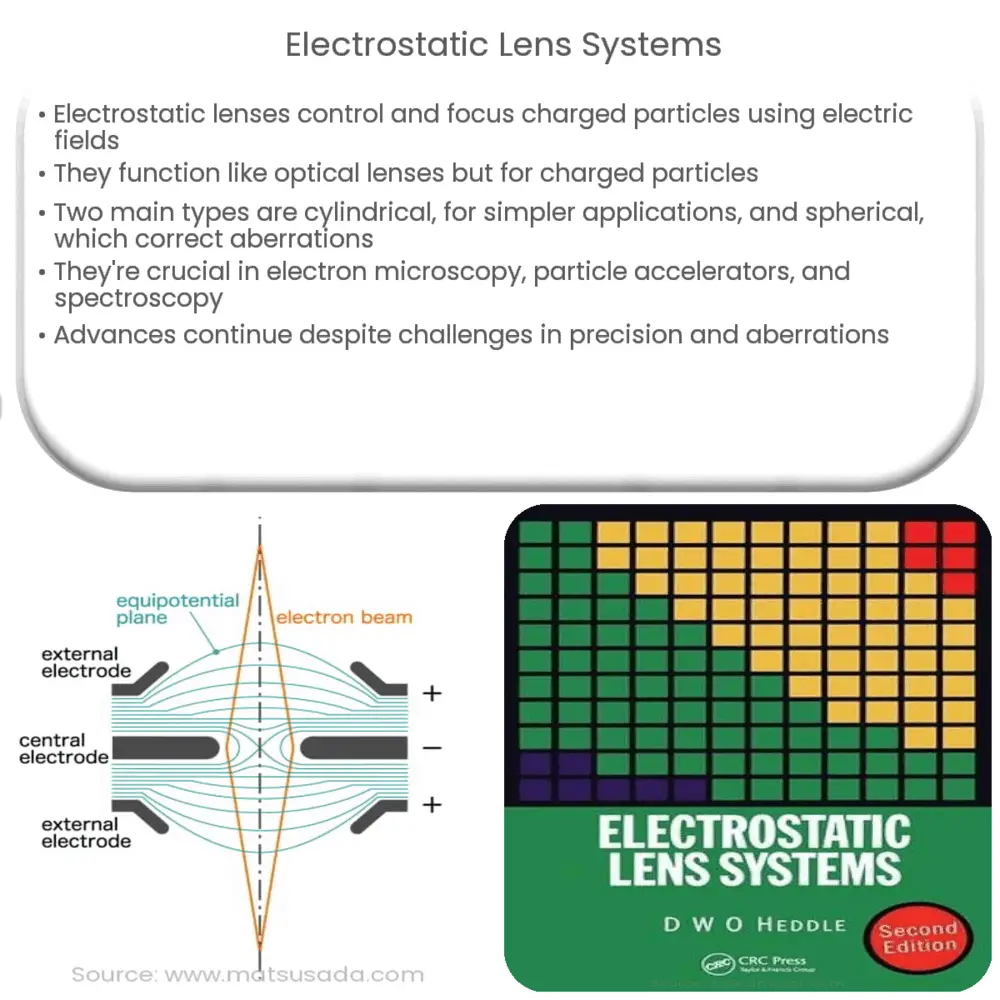Explore the intriguing world of electrostatic lens systems, their types, applications, design principles, and future prospects in our detailed guide.

Introduction to Electrostatic Lens Systems
Electrostatic lens systems, also known as electrostatic lenses, are vital components in various scientific and industrial applications. In the broadest sense, these lenses function by manipulating electric fields to control and focus charged particles, much like how traditional optical lenses manipulate light.
Working Principle of Electrostatic Lenses
The working principle of an electrostatic lens revolves around the electrostatic field it generates. When a voltage is applied to the lens, it creates an electric field. Charged particles moving through this field experience a force, which alters their path. The configuration and shape of the electric field determine how these particles will be focused or deflected.
Types of Electrostatic Lenses
- Cylindrical Lenses: These are the simplest type of electrostatic lenses. A typical cylindrical lens consists of two or more cylindrical electrodes. Their simplicity and robustness make them commonly used in applications where sophisticated control over particle paths isn’t required.
- Spherical Lenses: A more advanced type, spherical lenses offer improved focusing abilities. They consist of three or more concentric spherical electrodes. Their design enables them to correct spherical aberration, an issue that commonly plagues cylindrical lenses.
Applications of Electrostatic Lenses
Electrostatic lens systems find application in numerous scientific and technological fields. Some noteworthy examples include:
- Electron Microscopy: In electron microscopes, electrostatic lenses are utilized to focus electron beams onto the sample. This process enables the creation of detailed images at the atomic or molecular level.
- Particle Accelerators: Electrostatic lenses play a crucial role in particle accelerators, where they are used to focus and direct charged particle beams.
- Spectroscopy: In spectroscopic instruments, these lenses help to guide ions through the instrument, enhancing measurement precision and accuracy.
While the principle of operation remains constant, the specific configuration and usage of electrostatic lenses may vary depending on the application and the characteristics of the particles involved (like their charge and mass).
Design and Operation
The design and operational specifics of an electrostatic lens system are influenced by several factors. First, the charge and mass of the particles to be manipulated must be considered, as these directly affect how the particles will interact with the electric field. Also important is the particle’s initial velocity and the desired outcome (whether the particles should be focused into a point, deflected along a certain path, or dispersed).
Overall, an electrostatic lens system’s design is a delicate balance. It requires careful consideration and application of laws of electromagnetism, optics, and charged particle dynamics. Also, due to the inherent physical limitations and trade-offs, managing various optical aberrations (such as spherical and chromatic) becomes a critical part of the design process.
Advancements in Electrostatic Lens Systems
As with all fields of technology, electrostatic lens systems have seen significant advancements over the years. Modern lenses are increasingly sophisticated and capable, utilizing advanced materials and innovative designs to improve performance and versatility. For instance, multi-element lenses and adaptive lenses have been developed to offer more precise control over particle trajectories. Moreover, computational modelling and simulation have become essential tools in lens design and optimization, allowing for virtual prototyping and testing of lens systems.
Challenges and Future Prospects
Despite their advancements, electrostatic lenses are not without their challenges. Precision manufacturing, alignment, and calibration can be complex and costly, while high voltages and the need for vacuum conditions can pose operational challenges. Furthermore, managing lens aberrations remains a persistent concern. However, with ongoing research and development, these challenges are being continually addressed, paving the way for more powerful and efficient electrostatic lens systems in the future.
Conclusion
In conclusion, electrostatic lens systems are an invaluable tool in numerous scientific and industrial applications, from electron microscopy to particle accelerators. These lenses work by manipulating electric fields to control and focus charged particles, and their design is a delicate balance requiring careful consideration and application of various scientific laws. While they face certain challenges, ongoing advancements promise to enhance their capabilities, thus playing a crucial role in facilitating new discoveries and technological advancements in the years to come.

